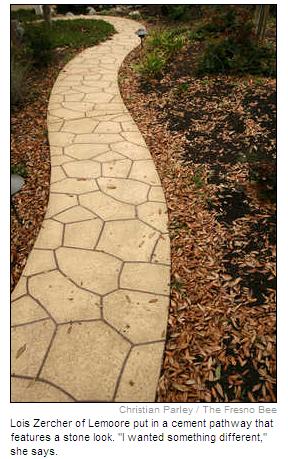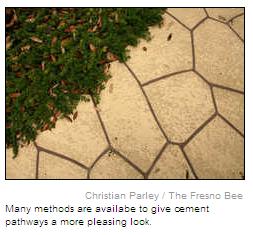

Tired of looking at the boring gray concrete in her yard, Lois Zercher of Lemoore decided to make it more attractive when she redesigned her backyard about two years ago.
"I wanted something different," says Zercher, a 57-year-old education administrator.
So she had a landscape designer extend the concrete around her patio, create a new curving concrete pathway from the patio to the side yard and build a small goldfish pond.
Since the landscaper didn't do decorative concrete, he recommended she contact Greg Kearns, president of Pacific Concrete Solutions, a division of Wildwood Aquatech Pools in Fresno.
Pacific Concrete Solutions came in and put down cream-colored concrete in a stone-style pattern on top of the existing concrete.
"Putting the pattern down really made a difference rather than leaving it plain," she says. "It has a more finished look."
Concrete gives homeowners lots of options when they want interesting pathways that do more than just give your feet places to walk.
Versatile pathways
What stands out about concrete as a pathway choice is that it gives you flexibility and permanence.
"It's durable," Kearns says. "You can shape it however you want it."
With concrete, you can leave it gray or spice it up with colors, patterns and textures. One of the easiest things you can do is color it, such as with stains.
There are several staining methods, including acids, solvents and water-based stains, says Paul Godfrey, the general manager of Carlton Concrete in Visalia. "Acids will last longer because they penetrate the concrete, whereas solvents and water-based [products] stay on top."
But the easiest for homeowners to use are water-based staining products.
"It's usually premixed, and you just go through [the top of the concrete] with a sprayer or roller and then leave it alone," he says.
There also are color products you can add to the concrete when it's being mixed or sprinkled on top of the concrete after it's poured, says Dan Tela, a partner at House of Concrete, a Fresno business that rents tools and sells supplies for concrete projects.
"Earth tones and reds are the most popular" colors, he says.
Making patterns with stamping mats also is an option. "It's fairly easy," Tela says. "It just depends on how big."
Stamping mats come in various sizes from 2 feet by 2 feet to 6 feet by 6 feet. At the House of Concrete, mats can be rented starting at $25 a day.
Overlays such as Zercher's, where a layer of concrete goes over existing concrete, also can be done. Patterns and textures can be added to the overlay with stamps, stencils and sprays. They cost $6 to $12 a square foot, depending upon the design, size and condition of the existing concrete, at Pacific Concrete Solutions.
Zercher paid between $5,000 and $6,000 for her decorative concrete. "I love it," she says, "so it was worth it."
Extras added to any concrete surface, such as score lines, can be decorative and functional. For example, score lines can be used to create a picture-frame look about 6 inches around the edge. In addition, these lines also help control with cracking. In pathway settings, the distance between score lines is often double the thickness of the concrete, says Doug Carlton, who founded Carlton Concrete.
Concrete also can have interesting textured finishes, too. The different ones noted at ConcreteNetwork.com are:
Float and trowel finishes: Swirl or arc patterns made with wood, aluminum or steel trowels.
Broom finishes: While not fancy, this finish is made with the bristles of a broom and provides a nonslip surface.
Rock salt finish: Water-softener salt crystals can be used to create a finish of small holes. The crystals are broadcast onto fresh concrete, then pressed into the surface with a roller. The small craters are made when the surface is later watered and the crystals dissolve.
Making your own path
"When I think of a pathway, I think of a journey," Carlton says, adding that it should be more than just going from point A to point B.
Make the pathway curve; make the journey interesting, he says.
In recent years, it has become easier to have your own concrete pathways, he says. Sure, you can still go buy bags of cement-and-sand mixtures and mix barrels of the materials with water. However, the use of short-load trucks, which can be rented to mix concrete, have made concrete projects more popular and easier for homeowners, Carlton says.
"It saves people money, gives them longer working time [with the concrete], and they pay for only what they use," he says.
Cemex in Fresno will deliver ready-mix concrete to homes by the cubic yard, with a 2-cubic-yard minimum. One cubic yard, or about 27 cubic feet, will cover an 81-square-foot area about 4 inches thick, says Mike Vryhof, the Cemex sales manager for the Fresno area.
"We just supply the concrete," he says. "That's a lot of our Saturday work. Most of the time, [homeowners] have a contractor do it.
"It's a perishable product. If it's not done right, it's a pretty expensive fix. Once it's poured, they have four to six hours to work with it, depending upon the weather."
Cost is $105 per cubic yard, not including delivery charges, which can start at $160 for 2 cubic yards and get less expensive with more cubic yards.
You also can rent cement mixers that you can tow to your home with a pickup truck.
Sunbelt Rentals in Fowler rents cement mixers that can hold about 7 cubic feet and can be rented for $80 for 24 hours. You just have to supply your own cement mix, such as those sold at home- improvement stores.
Unless you're doing a tiny area, don't expect it to be a one-day project. Work in phases and in 100-square-foot increments, Godfrey says.
"Don't exceed what you can do," he says.
With only several hours to work with the material before it begins to harden, "concrete is the ultimate team sport," Carlton says. "It's time- sensitive."
He also cautions you not to expect the concrete to be flawless.
"Homeowners need to realize they're going to save money [doing it themselves]," he says. "But it's not going to be perfect. ... It can be an unpredictable product."
The reporter can be reached at nzxiong@fresnobee.com or (559) 441-6467.

